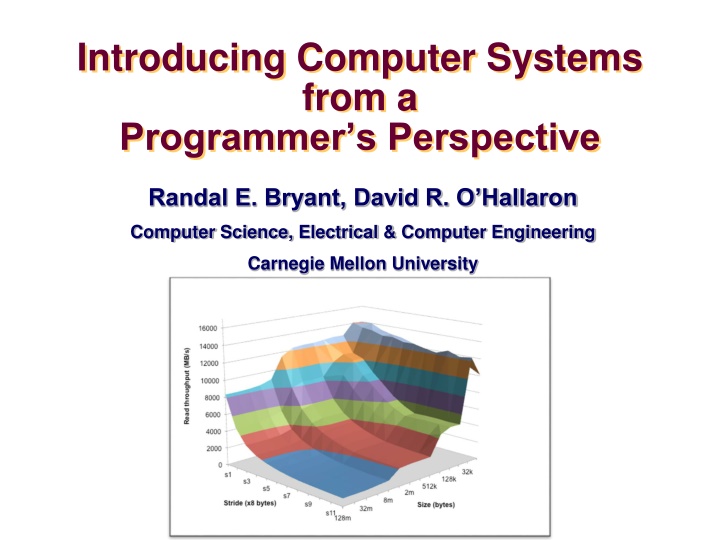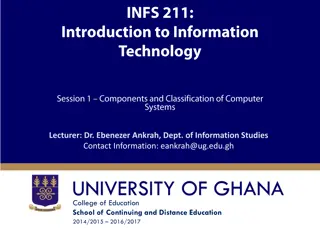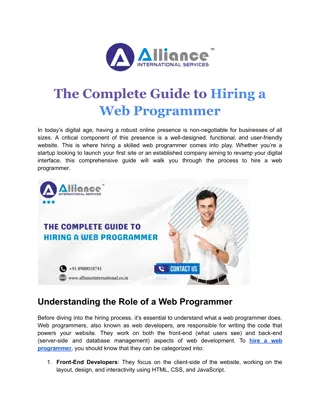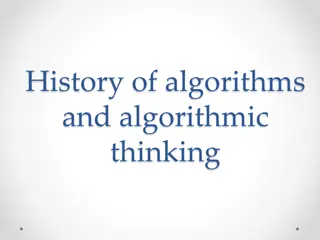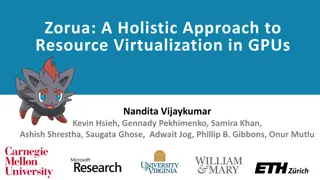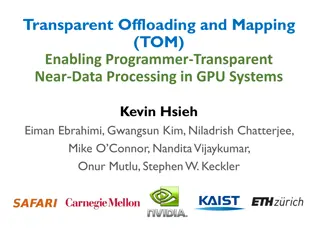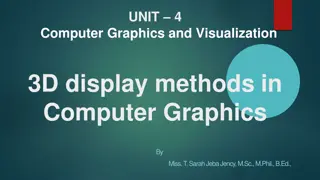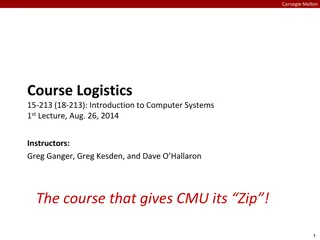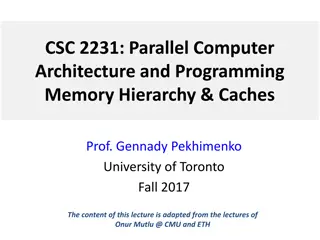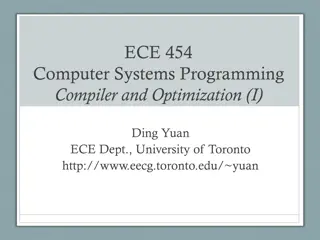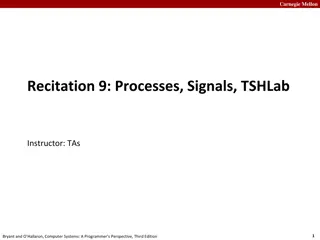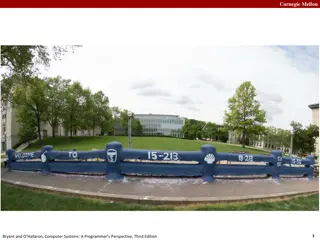Computer Systems from a Programmer's Perspective
This detailed content covers various aspects of computer systems as seen from a programmer's perspective. Topics range from computer arithmetic to memory system design, providing insights into key concepts and challenges. The content includes insights from a course taught at Carnegie Mellon University since 1998 and delves into the complexities of designing high-performance arithmetic circuits and memory systems.
Download Presentation

Please find below an Image/Link to download the presentation.
The content on the website is provided AS IS for your information and personal use only. It may not be sold, licensed, or shared on other websites without obtaining consent from the author.If you encounter any issues during the download, it is possible that the publisher has removed the file from their server.
You are allowed to download the files provided on this website for personal or commercial use, subject to the condition that they are used lawfully. All files are the property of their respective owners.
The content on the website is provided AS IS for your information and personal use only. It may not be sold, licensed, or shared on other websites without obtaining consent from the author.
E N D
Presentation Transcript
Introducing Computer Systems from a Programmer s Perspective Randal E. Bryant, David R. O Hallaron Computer Science, Electrical & Computer Engineering Carnegie Mellon University
Outline Introduction to Computer Systems Course taught at CMU since Fall, 1998 Some ideas on labs, motivations, Computer Systems: A Programmer s Perspective Our textbook, now in its third edition Ways to use the book in different courses ICS 2
Background 1995-1997: REB/DROH teaching computer architecture course at CMU. Good material, dedicated teachers, but students hate it Don t see how it will affect their lives as programmers Course Evaluations 5 4.5 CS Average 4 3.5 REB: Computer Architecture 3 2.5 2 1995 1996 1997 1998 1999 2000 2001 2002 ICS 3
Computer Arithmetic Builder s Perspective 32-bit Multiplier How to design high performance arithmetic circuits ICS 4
Computer Arithmetic Programmer s Perspective void show_squares() { int x; for (x = 5; x <= 5000000; x*=10) printf("x = %d x^2 = %d\n", x, x*x); } 5 x2 = 50 x2 = 500 x2 = 5000 x2 = 50000 x2 = x = x = x = x = x = x = 500000 x2 = x = 5000000 x2 = 25 2500 250000 25000000 -1794967296 891896832 -1004630016 Numbers are represented using a finite word size Operations can overflow when values too large But behavior still has clear, mathematical properties ICS 5
Memory System Builder s Perspective Builder s Perspective Direct mapped or set indexed? Synchronous or asynchronous? Write through or write back? L1 d-cache L2 Regs Main memory unified cache Disk CPU L1 i-cache Virtual or physical indexing? How many lines? Must make many difficult design decisions Complex tradeoffs and interactions between components ICS 6
Memory System Programmer s Perspective void copyij(int src[2048][2048], int dst[2048][2048]) { int i,j; for (i = 0; i < 2048; i++) for (j = 0; j < 2048; j++) dst[i][j] = src[i][j]; } void copyji(int src[2048][2048], int dst[2048][2048]) { int i,j; for (j = 0; j < 2048; j++) for (i = 0; i < 2048; i++) dst[i][j] = src[i][j]; } 4.3 ms 81.8 ms (Measured on 2 GHz Intel Core i7 Haswell) 19 times slower! Hierarchical memory organization Performance depends on access patterns Including how step through multi-dimensional array ICS 7
The Memory Mountain ICS 8
Background (Cont.) 1997: OS instructors complain about lack of preparation Students don t know machine-level programming well enough What does it mean to store the processor state on the run- time stack? Our architecture course was not part of prerequisite stream ICS 9
Birth of ICS 1997: REB/DROH pursue new idea: Introduce them to computer systems from a programmer's perspective rather than a system designer's perspective. Topic Filter: What parts of a computer system affect the correctness, performance, and utility of my C programs? 1998: Replace architecture course with new course: 15-213: Introduction to Computer Systems Curriculum Changes Sophomore level course Eliminated digital design & architecture as required courses for CS majors ICS 10
15-213: Intro to Computer Systems Goals Teach students to be sophisticated application programmers Direct benefit to students who never take another systems course Prepare students for upper-level systems courses Taught every semester to 400+ students All CS undergrads (core course) All ECE undergrads (core course) Many masters students To prepare them for upper-level systems courses Variety of others from math, physics, statistics, Preparation Optional: Introduction to CS in Python or Ruby Imperative programming in C subset ICS 11
ICS Feedback Students Course Evaluations 5 REB: Intro. Comp. Systems 4.5 CS Average 4 3.5 REB: Computer Architecture 3 2.5 2 1995 1996 1997 1998 1999 2000 2001 2002 Faculty Prerequisite for most upper level CS systems courses Also required for ECE embedded systems, architecture, and network courses ICS 12
Lecture Coverage Data representations [3] It s all just bits. int s are not integers and float s are not reals. x86-64 machine language [5] Analyzing and understanding compiler-generated machine code. Program optimization [2] Understanding compilers and modern processors. Memory Hierarchy [3] Caches matter! Linking [1] With DLL s, linking is cool again! ICS 13
Lecture Coverage (cont) Exceptional Control Flow [2] The system includes an operating system that you must interact with. Virtual memory [4] How it works, how to use it, and how to manage it. Application level concurrency [3] Processes and threads Races, synchronization I/O and network programming [4] Programs often need to talk to other programs. Total: 27 lectures, 14 week semester ICS 14
Labs Key teaching insight: Cool Labs Great Course A set of 1 and 2 week labs define the course. Guiding principles: Be hands on, practical, and fun. Be interactive, with continuous feedback from automatic graders Find ways to challenge the best while providing worthwhile experience for the rest Use healthy competition to maintain high energy. ICS 15
Lab Exercises Data Lab (2 weeks) Manipulating bits. Bomb Lab (2 weeks) Defusing a binary bomb. Attack Lab (1 week) Buffer overflow and return-oriented programming exploits Cache Lab (2 weeks) Write basic cache simulator and then optimize application Shell Lab (1 week) Writing your own shell with job control. Malloc Lab (2-3 weeks) Writing your own malloc package. Proxy Lab (2 weeks) Writing your own concurrent Web proxy. ICS 16
Data Lab Goal: Solve some bit puzzles in C using a limited set of logical and arithmetic operators. Examples: absval(x), greaterthan(x,y), log2(x) Lessons: Information is just bits in context. C int s are not the same as integers. C float sare not the same as reals. Infrastructure Configurable source-to-source C compiler that checks for compliance. Instructor can automatically select from 45 puzzles. Automatic testing using formal verification tools ICS 17
Lets Solve a Bit Puzzle! /* * abs - absolute value of x (except returns TMin for TMin) * Example: abs(-1) = 1. * Legal ops: ! ~ & ^ | + << >> * Max ops: 10 * Rating: 4 */ int abs(int x) { int mask = x>>31; 11 12, = 1, 00 02, = 0, x < 0 x 0 (x^mask) + 1+~mask return ____________________________; } x 1, x < 0 x, 1, x < 0 0, x 0 x, x, x < 0 x 0 + = x 0 ICS 18
Bomb Lab Idea due to Chris Colohan, TA during inaugural offering Bomb: C program with six phases. Each phase expects student to type a specific string. Wrong string: bomb explodes by printing BOOM! ( pt) Correct string: phase defused (+10 pts) In either case, bomb sends message to grading server Server posts current scores anonymously and in real time on Web page Goal: Defuse the bomb by defusing all six phases. For fun, we include an unadvertised seventh secret phase The challenge: Each student get only binary executable of a unique bomb To defuse their bomb, students must disassemble and reverse engineer this binary ICS 19
Properties of Bomb Phases Phases test understanding of different C constructs and how they are compiled to machine code Phase 1: string comparison Phase 2: loop Phase 3: switch statement/jump table Phase 4: recursive call Phase 5: pointers Phase 6: linked list/pointers/structs Secret phase: binary search (biggest challenge is figuring out how to reach phase) Phases start out easy and get progressively harder ICS 20
Lets defuse a bomb phase! 0000000000400a6c <phase_2>: ... # function prologue not shown 400a72: mov %rsp,%rsi 400a75: callq 4010ba <read_six_numbers> 400a7a: cmpl $0x1,(%rsp) 400a7e: je 400a85 <phase_2+0x19> 400a80: callq 400f6d <explode_bomb> 400a85: lea 0x4(%rsp),%rbx 400a8a: lea 0x18(%rsp),%rbp 400a8f: mov -0x4(%rbx),%eax 400a92: add %eax,%eax 400a94: cmp %eax,(%rbx) 400a96: je 400a9d <phase_2+0x31> 400a98: callq 400f6d <explode_bomb> 400a9d: add $0x4,%rbx 400aa1: cmp %rbp,%rbx 400aa4: jne 400a8f <phase_2+0x23> ... # function epilogue not shown 400aac: c3 retq # rd 6 ints into buffer # p = &buf[1] # pend = &buf[6] # LOOP: v = buf[0] # v = 2*v # if v == *p # then goto OK: # else explode! # OK: p++ # if p != pend # then goto LOOP: # YIPPEE! ICS 21
The Beauty of the Bomb For the Student Get a deep understanding of machine code in the context of a fun game Learn about machine code in the context they will encounter in their professional lives Working with compiler-generated code Learn concepts and tools of debugging Forward vs backward debugging Students must learn to use a debugger to defuse a bomb For the Instructor Self-grading Scales to different ability levels Easy to generate variants and to port to other machines ICS 22
Attack Lab int getbuf() { char buf[4]; /* Read line of text and store in buf */ gets(buf); return 1; } Task Each student assigned cookie Randomly generated 8-digit hex string Generate string that will cause getbuf to call function touch2 with cookie as argument Instead of 1 ICS 23
Buffer Code Stack when gets called Stack Frame for test void test(){ int v = getbuf(); ... } Return address Return Address (8 bytes) void getbuf() { char buf[4]; gets(buf); return 1; } Increasing addresses 20 bytes unused [3][2][1][0] buf %rsp Calling function gets(p)reads characters up to \n Stores string + terminating null as bytes starting at p Assumes enough bytes allocated to hold entire string ICS 24
Exploit String Example Stack after call to gets() test stack frame void getbuf() { char buf[12]; gets(buf); return 1; } B pad data written by gets() Sets 0x59b997fa as function argument Invokes function touch2 getbuf stack frame exploit code B /* Byte code for shell code movq $0x59b997fa,%rdi; ret */ 48 c7 c7 fa 97 b9 59 c3 /* Pad with 16 bytes */ 00 00 00 00 00 00 00 00 00 00 00 00 00 00 00 00 /* Address of shellcode */ 78 dc 61 55 00 00 00 00 /* Address of touch2 */ 0c 18 40 00 00 00 00 00 ICS 25
Why Do We Teach This Stuff? Important Systems Concepts Stack discipline and stack organization Instructions are byte sequences Making use of tools Debuggers, assemblers, disassemblers Computer Security What makes code vulnerable to buffer overflows Common vulnerability in systems Impact CMU student teams consistently win international Capture the Flag Competitions ICS 26
CMU Courses that Build on ICS Robotics ECE CS Parallel Prog. Dist. Systems Cog. Robotics Embedded Control Compilers Secure Coding Storage Systems Comp. Photo. Real-Time Systems Networks Software Engin. Operating Systems Computer Graphics Embedded Systems Computer Arch. Databases ICS ICS 27
Fostering Friendly Competition Desire Challenge the best without frustrating everyone else Method Web-based submission of solutions Server checks for correctness and computes performance score How many stages passed, program throughput, Keep updated results on web page Students choose own nom de guerre Relationship to Grading Students get full credit once they reach set threshold Push beyond this just for own glory/excitement ICS 28
Shameless Promotion http://csapp.cs.cmu.edu Third edition published 2015 In use at 289 institutions worldwide ICS 29
Coverage Material Used by ICS at CMU Pulls together material previously covered by multiple textbooks, system programming references, and man pages Greater Depth on Some Topics Dynamic linking I/O multiplexing Additional Topic Computer Architecture Added to cover all topics in Computer Organization course ICS 30
Architecture Material Y86-64 instruction set Simplified/reduced x86-64 Implementations Sequential 5-stage pipeline Presentation Simple hardware description language to describe control logic Automatic translation to simulator and to Verilog Labs Modify / extend processor design New instructions Change branch prediction policy Optimize application + processor ICS 31
Worldwide Adoptions 289 total ICS 32
Conclusions ICS Has Proved Its Success Many thousands of students at CMU over 18 years Positive feedback from alumni Positive feedback from systems course instructors CS:APP is International Success Supports variety of course styles Many purchases for self study ICS 33
